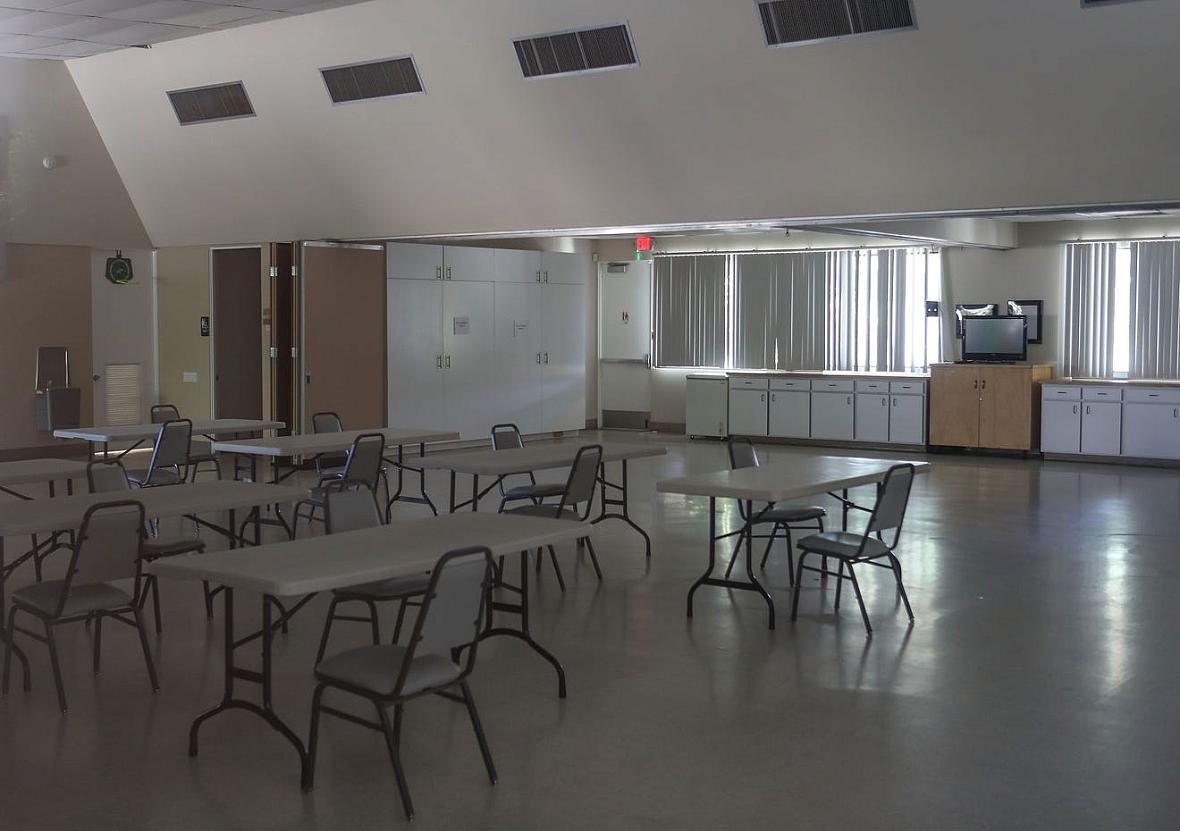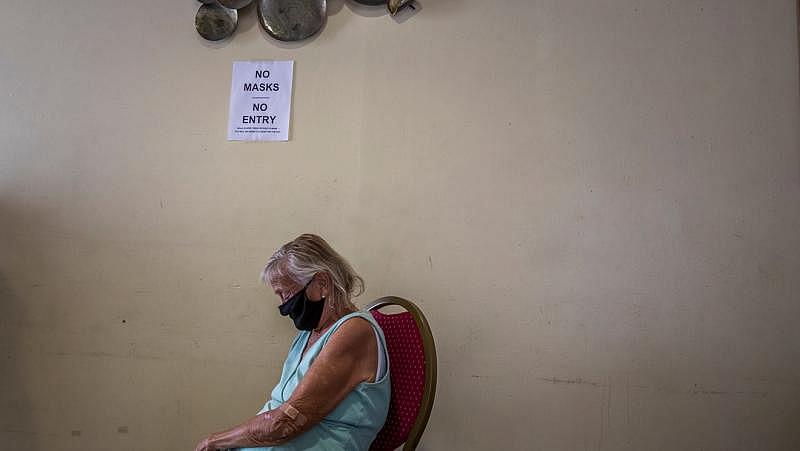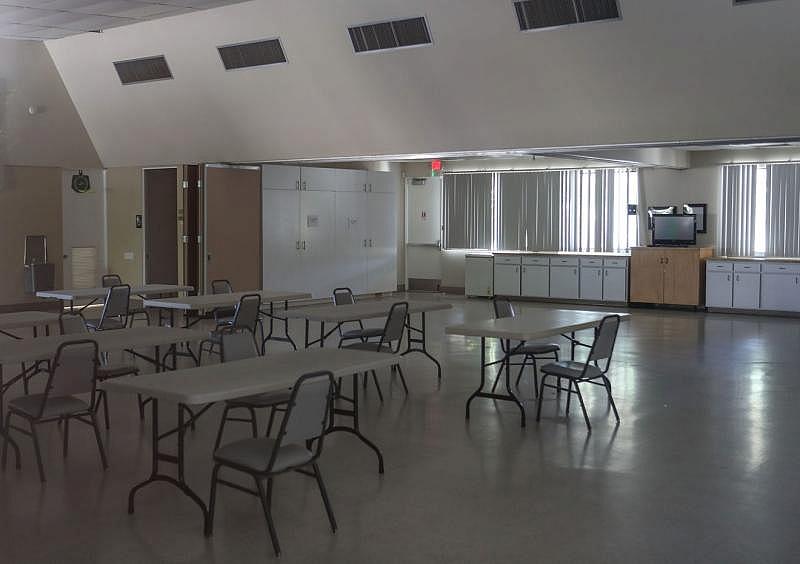3 emergency shelters close due to lack of funding, leaving no options for homeless in Palm Springs area
This story was produced as part of a larger project led by Nicole Hayden, a participant in the USC Center for Health Journalism's 2020 California Fellowship.
Her other stories in this project include:
Riverside County advocates want COVID-19 testing for homeless on the streets
Palm Springs shelter avoided COVID-19. Homeless say they need more than protection from virus
Project Roomkey funding ends soon. Over 11,000 Californians could become homeless, again

Jay Calderon/ The Desert Sun
The western Coachella Valley's three overnight homeless shelters have closed as Riverside County officials cite lack of funds to continue operations, sending nearly 100 individuals back onto the streets amid the COVID-19 pandemic.
While the county is currently working with the city of Palm Springs to identify a long-term solution that addresses both the need for shelter beds and permanent housing, there is no immediate solution in sight. Palm Springs officials say the county is responsible for funding a long-term emergency homeless shelter, but the county says it's not within their budget — emergency funds that were temporarily allocated to the cause have been depleted, and a larger allocation from the state or federal government is needed.
"These three sites were always determined to be temporary summer facilities," said Greg Rodriguez, policy advisor for Riverside County Supervisor V. Manuel Perez, who also leads collaborative homeless efforts in the Coachella Valley. "The real issue is the cost and availability of resources."
Of the three temporary shelters, the Desert Hot Springs and Cathedral City locations opened at the start of summer to provide relief from the heat while the Palm Springs shelter has been open since last July. The pandemic has only heightened the need for ongoing shelter as the economic toll of the past seven months led to an increase in homelessness. Each shelter, which provided beds, food and case worker resources, operated at capacity — 30 people — every night.
As a result of the closures on Sept. 29, the nearest emergency shelter for the western Coachella Valley’s homeless population — estimated to be around 300 individuals, according to the 2020 Riverside County point-in-time count — is now more than 20 miles away in Indio. That's a difficult journey without a car, and even more so if carrying a bag or cart full of personal possessions.
“I think it’s really horrible to close this place, especially during a pandemic right now,” 56-year-old George Smith said while lying on a cot, wrapped loosely in a thin blanket, his last night before the Palm Springs shelter closed. “I just want to ask the people who made this decision, ‘Why did you do this?’”
George Smith tries to stay cool during triple-digit temperatures in the shade of a wall at Sunrise Park after the closure of the overnight shelter for the homeless in Palm Springs, September 30, 2020. Jay Calderon/The Desert Sun
The shelter’s lights were dimmed that Tuesday evening, and people spoke in a whisper to allow others to fall asleep early. It was quiet and calm, and Smith said he felt safe there. He was wary of navigating life outside of the bubble that the shelter clients had created — they all slept distanced from each other.
“This place was a life-saver for people with many different backgrounds,” said Sergio Delafuente, 60. “It served people who had good jobs that were lost during the pandemic — I even met a Realtor. I was a server at a high-end restaurant before things shut down. I plan to go back to work, but I can’t show up without a shower. This place provides those dignities — a bathroom, a shower, food, a safe place so we can sleep.”
Rodriguez said providing resources for individuals experiencing homelessness continues to be a priority for the county. But funding remains the "main" challenge to a long-term solution, he said. Other overnight shelters in the Coachella Valley are funded largely by donations and grants.
“It’s not just about building something," Rodriguez said. "It’s about sustainability and ongoing operations.”
Operating costs lead to shut down
This isn't the first threat of closure for county-funded emergency shelter in the western Coachella Valley, where there are no permanent options.
The Palm Springs location has operated on a month-by-month basis for more than a year, as funding ping-ponged between the county, the city of Palm Springs, the Desert Healthcare District, and state and federal dollars.
Most recently, it was funded by CARES Act dollars, which are federal monies handed down through the state intended to provide shelter for people during the coronavirus pandemic. But Rodriguez says that pot of funding has dried up.
The California Department of Social Services did not respond to a request for comment on the availability of additional funding for emergency homeless services during the pandemic.
Curtis Cummings talks about the closure of the Desert Hot Springs overnight homeless shelter has made his life more difficult as he now sleeps on the ground and out in the open in downtown Palm Springs, October 1, 2020. Cummings was trying to stay cool at the Well in the Desert cooling center in Palm Springs as triple-digit temperatures linger in the Coachella Valley. Jay Calderon/The Desert Sun.
Riverside County received $431 million in CARES Act funding. Of that total, $48.7 million was allocated for homelessness — Rodriguez said the Coachella Valley received a greater portion of that funding than other parts of the county.
About $300,000 of that went to the three shelters, and the Desert Healthcare District pitched in $20,000 to cover utilities at the facilities. The rest of the CARES Act homeless funding went toward other shelters and services throughout the county.
Aside from that one-time pot of pandemic-specific funding, the county typically receives about $14 million annually from the state and federal government for homeless services.
Overall, Riverside County typically spends about $80 million annually on homeless services, said Jose Arballo, county spokesman. But "the county funding for homelessness is already allocated, so there is not a source of funds to dip into for a Palm Springs shelter," Rodriguez said.
Already this year, the Palm Springs shelter downsized its capacity from about 50 people to 30, and moved locations to accommodate social distancing requirements. The two overnight cooling centers in Cathedral City and Desert Hot Springs were opened to help handle the demand spread throughout the valley.
A woman cools down at the Well in the Desert, a designated cooling center in Palm Springs, California on August 19, 2020. Temperatures reached over 110 degrees. Omar Ornelas/The Desert Sun
It costs $30,000 per month to operate each shelter. The county contracted with the Coachella Valley Rescue Mission, which is based in Indio, to provide onsite management and services at all three.
CVRM shelter leader Arnold Giles said they'd be interested in permanently expanding services to Palm Springs. However, the mission, which reported $7.9 million in expenses last year, wouldn’t be able to do so without additional funding.
Arlene Rosenthal, who operates The Well in the Desert, a daytime homeless resource center in Palm Springs, said available state and federal funds should be used to provide safe places for people to sleep.
"Once again, we will have people sleeping outside in the elements and where it is not safe," she said. "I am very sad and angry
Palm Springs prioritizes housing
The city of Palm Springs still has $7 million of a $10 million state allocation to be used for homeless services, but Mayor Geoff Kors said that funding is earmarked for permanent supportive housing, which is slated to be built in the next couple years.
Kors said it is not clear if that funding could also be used for temporary emergency shelter. He is hoping other state funding will become available.
“The state has made a commitment to provide shelter for people who would otherwise be living on the streets during the COVID-19 pandemic,” Kors said. “We would hope the county would still have access to state or federal funding for this purpose.”
It would cost $360,000 annually to keep the doors open at the shelter in Palm Springs, which is home to 63% of the west valley’s homeless population.
Additional funding would be necessary to provide the deeper programming resources it takes to allow the shelter to act as a transitional living center that could help people move into more long-term permanent housing. Palm Springs officials have continually stressed their plan to prioritize long-term solutions.
Palm Springs Mayor Pro Tem Christy Holstege said she was glad to see the county initially open the shelter last summer — it’s something the city had been calling on the county to do since Roy’s Desert Resource Center closed in 2017.
“It’s incredibly important to have a place for people to stay overnight especially during a pandemic,” Holstege said. “I know there are funding restrictions, but we would very much like to see a shelter continue so people have a place to sleep.”
90 people sleeping without shelter again
Smith found a new place to sleep by Wednesday. Late in the afternoon, as the temperature hit 109 degrees, he sat against a shaded wall in Sunrise Park in Palm Springs. He was alone and tucked out of the view of passersby. He planned to stay there until 10 p.m., when the park closed. Then, he would move a short distance to the sidewalk that bordered the park, where police wouldn’t ask him to move.
He would either sleep on the sidewalk or on a bus stop bench if available, he said.
“One question we have for the county is what is happening to the people who were at these shelters?” said Kors, who noted his concern is heightened amid the pandemic.
There have been no reported coronavirus outbreaks at shelters in the Coachella Valley. Shelter clients say they feel safer at the shelter, having created their own bubble away from others. Additionally, a shelter provides people access to sanitary necessities such as bathrooms, showers and socially distanced places to sleep. Some individuals experiencing homelessness report they can't wash their hands as recommended because some local businesses won't allow them access to bathrooms.
Homeless communities across the state have not been this lucky. Coronavirus spread through encampments and shelters in Los Angeles County and the Bay Area, compounded by the fact that homeless individuals often lack access to health care and have chronic conditions that can make COVID-19 symptoms worse.
Coachella Valley Rescue Mission development director Scott Wolf said his staff offered to take any west valley clients to the rescue mission in Indio for services and shelter.
A handful of clients on Wednesday said they were offered that option but didn’t want to leave Palm Springs, the city they were familiar with. Most headed back to the streets.
As Smith left the shelter for the final time that morning, he said he wasn’t offered the opportunity to go to the mission.
Shelter protects women from violence
Overnight shelters can also be a refuge for women — as well as seniors, LGBTQ individuals and people with a disability — who experienced abuse prior to becoming homeless or violence while living on the streets. Three local women on Tuesday described similar fears of what they will face in the coming weeks of living on the streets of Palm Springs, now that the shelter is shut down for good.
Cheryl Shannon, who is 61 and disabled, became homeless after she left her ex-husband. She said his physical abuse caused neurological damage that led to constant seizures. Since living out of her vehicle, Shannon said her truck windows have been smashed in and her purse has been stolen.
While on a "waitlist" for a home, Shannon has ended up in the Desert Regional Medical Center emergency room for heat-related illnesses such as dehydration in recent months. She fears temperatures have yet to catch up to the fall season.
The United Methodist Church in Palm Springs was being used as an overnight shelter for the homeless until funding ran out on Wednesday, September 29, 2020. Jay Calderon/The Desert Sun
June Tipton, who is 63 and disabled, revealed physical scars from being raped twice while living on the streets of Palm Springs.
“Women have no chance against men like that. I am thankful for place like this,” Tipton said, referring to the shelter she was staying at.
Sara Barti, who is 56 and between jobs, said she has been robbed and has been continuously followed by a man who verbally harasses her.
“I wish they would stay open,” Shannon said of the shelters. “It’s all we have. They don’t let us go anywhere else. Places don’t just let you park and sleep in your car, and they don’t like us sleeping in the park. I felt safe here.”
Desert Sun reporter Nicole Hayden covers health in the Coachella Valley. She can be reached at Nicole.Hayden@desertsun.com or (760) 778-4623. Follow her on Twitter @Nicole_A_Hayden.
[This story was originally published by Desert Sun.]

